Utilities and Auxiliary Systems
Created by Commodore Wilkan Targaryen on Sat Dec 21st, 2024 @ 1:19pm
Cargobays
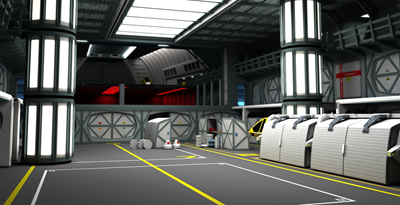 Because of the long-term nature of their missions, Federation vessels carry a variety of equipment and supplies to support crew and mission objectives. Most of these large objects or bulk supplies are stored in the Enterprise's Cargobays, Among the largest locations aboard the starship, the Enterprise maintains a variety of Cargobays aboard the ship in both the Primary and Secondary Hulls. Inspired by the Cargobay of the Constitution II Class, the largest Cargobay aboard the Century Class is directly connected to Shuttlebays 1 and 2 in the Primary Hull and provide one large, cavernous Cargo Bay that can be directly accessed by Shuttlecraft and Work Bees.
Because of the long-term nature of their missions, Federation vessels carry a variety of equipment and supplies to support crew and mission objectives. Most of these large objects or bulk supplies are stored in the Enterprise's Cargobays, Among the largest locations aboard the starship, the Enterprise maintains a variety of Cargobays aboard the ship in both the Primary and Secondary Hulls. Inspired by the Cargobay of the Constitution II Class, the largest Cargobay aboard the Century Class is directly connected to Shuttlebays 1 and 2 in the Primary Hull and provide one large, cavernous Cargo Bay that can be directly accessed by Shuttlecraft and Work Bees.
Communications
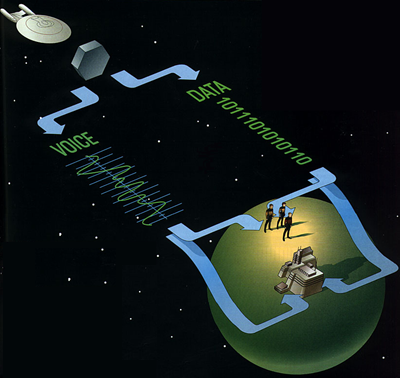
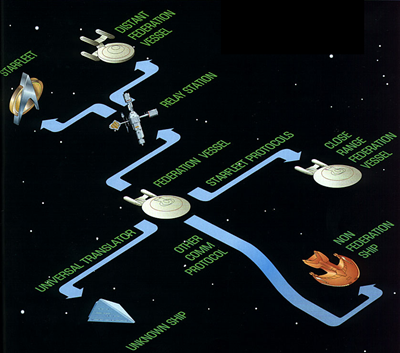 If the Bridge is the Brain of the Starship and Engineering is its heart, then Communications is its ears and its voice. One of the most complex and varied disciplines onboard the Enterprise, a starship can use its subspace radio and other communications devices to contact just about anyone in the galaxy.
If the Bridge is the Brain of the Starship and Engineering is its heart, then Communications is its ears and its voice. One of the most complex and varied disciplines onboard the Enterprise, a starship can use its subspace radio and other communications devices to contact just about anyone in the galaxy.Communications technologies have grown in capability and sophistication in the centuries since the founding of the United Federation of Planets, but the underlying concept remains relatively unchanged. Starfleet ships incorporate Subspace Transceiver Assemblies located at various points along the outer hull to fulfill both their long- and short-range communications needs. Short-range transceivers have a maximum range of around 100,000 kilometers and are primarily utilized for ship-to-ground communications while the long-range transceivers have a maximum range of 25 light-years and are normally used for ship-to-ship communications and contact with distant worlds. To overcome the signal degradation that occurs when the signal passes 25 light-years Starfleet has established a network of manned and unmanned Subspace Relay Stations to allow distant communications.
While Subspace Radio travels at speeds faster than most Starfleet vessels, instantaneous communication with distant locations is not always possible. Often communications lags of hours or days may occur based upon the distance or encountered interference, but - in most cases - these lags have been minimal. This is important as many communications from Starfleet itself contain confidential, classified, or other secret information that is of importance to the Enterprise and her mission. Starfleet Communications has developed secured channels using advanced encryption algorithms to prevent outsiders from eavesdropping on the transmissions that require specific authorization codes to access. Messages may also be disguised to prevent their interception by an enemy. Despite these advancements, military secrets remain the most fleeting in the galaxy and often these channels may be accessed by threat forces, requiring the development of new secured networks. In the event that a bad actor is sending secret messages from the Enterprise, the crew can use a Signal Correlation Trace to determine where a communication was sent from.
During combat situations the Communications abilities of the vessel become even more important. While the Tactical Officer fights an open battle, the Communications Officer's struggle is often silent as they work to overcome risks to the Communications systems of the Enterprise. Often, enemies will attempt to generate energy fields or other interfere to prevent Communications. These attacks, such as a rotating EM pulse, antilepton interference, or broad-band inversion field, can prevent communications and it is the job of the Communications Officer to overcome (or cause) this interference. As each starship in the galaxy has a unique Prefix Code that is used to gain remote access to the ship, the Communications equipment can be used in an effort to hack this code and gain access to the opponent's computers to review information or even attempt to disable the craft. Should the crew be at risk of losing control of their own vessel, the Communications and Computer equipment can be encrypted to prevent loss of control of the ship.
Emergency Communications
Normally the Emergency Communications Transmitter was attached to a bulkhead and attached to the Enterprise's communications systems. In the event of an abandon ship scenario or the Enterprise was captured by enemy forces, the Transmitter could be extracted from its housing and taken with the Starfleet Officer to be used elsewhere. When detached from the starship the transmitter assembly was required to operate under its own power, preventing any type of two-way communications due to energy limitations. Instead, the Emergency Transmitter could be used to send an emergency locator signal to nearby friendlies for assistance.
Holocommunications
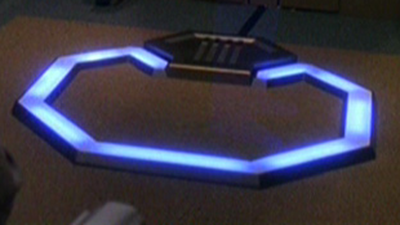 Originated in the 23rd Century, Holocommunications uses a specialized transceiver assembly to allows its users to communicate as if they were in the same room by projecting holograms of each other via subspace bands. Somewhat glitchy at the time and prone to causing interference with other shipboard systems, after Captain Christopher Pike's U.S.S. Enterprise suffered a critical systems failure that crippled the starship, the Starfleet Corps of Engineers was able to determine that the holographic communications system had been the root cause of the cascade failure. Starfleet Command chose to cancel deployment of additional holocommunications systems after the Enterprise debacle, opting instead to rely upon the traditional two-dimensional communications options of the past.
Originated in the 23rd Century, Holocommunications uses a specialized transceiver assembly to allows its users to communicate as if they were in the same room by projecting holograms of each other via subspace bands. Somewhat glitchy at the time and prone to causing interference with other shipboard systems, after Captain Christopher Pike's U.S.S. Enterprise suffered a critical systems failure that crippled the starship, the Starfleet Corps of Engineers was able to determine that the holographic communications system had been the root cause of the cascade failure. Starfleet Command chose to cancel deployment of additional holocommunications systems after the Enterprise debacle, opting instead to rely upon the traditional two-dimensional communications options of the past. During the Cold War between the United Federation of Planets and the Dominion, Starfleet Research & Development chose to revisit the holocommunications system for deployment on front-line starships. These initial prototypes were deployed on a handful of starships (including the Defiant, Enterprise, and the Malinche) and required a specialized holoemitter pad from which the three-dimensional replica of the person would generate during the transmission. Capable of being wall mounted or integrated into the floor, the communications process was relatively the same as opening a standard channel. The technology was abandoned once more during the Dominion War, but made a resurgence during the reconstruction period and became more efficient due to many vessels incorporating holoemitters throughout the ship, eliminating the need for the specialized emitters.
While two-dimensional communication is still the standard aboard the Starship Enterprise, the vessel has been fitted with the appropriate equipment to support three-dimensional communications. One special advantage of the Holocommunications equipment is that it can be used to apply filters to a transmission to assist in covert actions. This specialized software alters the overall appearance of the transmission's origin location and can modify the people to appear as if they are in another location, are other people, or are even of an entirely different species. Normally used during holographic communications, the filters can be applied to traditional transmissions as well.
Universal Translator
A key component of the Communications System, the Universal Translator contains specialized algorithms designed to analyze spoken or written language for translation into a language that the user can understand. Containing thousands of languages within its databases, the Universal Translator reviews conversations, messages, or text and compares the contents to information stored in its database. In most cases the Universal Translator enables immediate translation of the contents, allowing each participant to hear or read the other’s communication in their native language.While an advanced system, the Universal Translator is not perfect and can experience challenges during its operations. For many users the usage of the Universal Translator is obvious as the speech comes from the device, not from the persons who are speaking. Further, while the linguistic database is extensive, it does not include every known language in the galaxy. If the language its monitoring is not in the database, the Universal Translator takes time to analyze the communication and to deliver a translation. Under normal circumstances the Universal Translator needs at least 30 minutes to process an unknown language, but more exposure to the language typically decreases the length of time needed for translation. In the event that a language is highly complicated or exotic, such as the Cairn or Tamarian languages, the translation will require more processing time.
Navigational Deflector
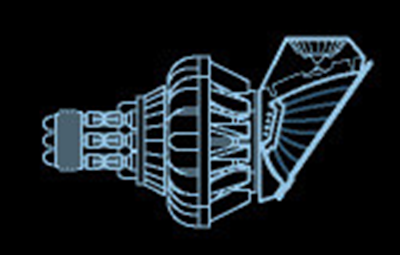
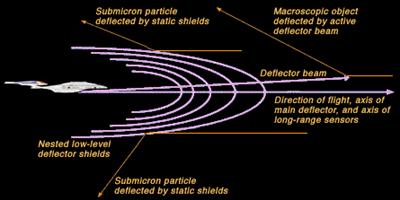 To a vessel traveling at even slower than light speeds any type of collision can be devastating to the safety of the ship and crew, potentially wearing down the outer hull or even destroying it with a simple impact. With space actually full of a variety of hidden dangers, Starfleet vessels like the Enterprise have been outfitted with use a Navigational Deflector designed to repel these dangers and push them out of the vessel's flightpath.
To a vessel traveling at even slower than light speeds any type of collision can be devastating to the safety of the ship and crew, potentially wearing down the outer hull or even destroying it with a simple impact. With space actually full of a variety of hidden dangers, Starfleet vessels like the Enterprise have been outfitted with use a Navigational Deflector designed to repel these dangers and push them out of the vessel's flightpath.Different than the Deflector Shields, the Navigational Deflector Dish is one of the largest systems aboard the Enterprise and is prominently featured on the forward edge of the vessel's hull. The Navigational Deflector on Enterprise comprises four high-powered graviton polarity source generators producing five nested parabolic shields to sweep aside stray hydrogen atoms and submicron particulates and a deflector beam capable of repelling larger objects. At sublight and low Warp velocities only one Deflector generator is required to be operational. At mid-Warp speeds, at least two of the Deflectors must be functional, while high Warp requires three generators. As the Enterprise approaches its maximum velocity, all four generators must be active (with the option of raising the Deflector Shields). If the Deflector generators are unavailable or lack sufficient power, the ship will likely suffer damage as it travels, if not be destroyed.
As members of the Century Class are often assigned to five-year missions away from Federation territory, these ships are equipped with an Auxiliary Navigational Deflector built into the superstructure of the Saucer Module. Pioneered on the Intrepid Class in the late-24th Century, the Auxiliary Deflector Dish is half the size of the Primary Deflector and incorporates two graviton polarity source generators. While not in use the Auxiliary Deflector Dish is covered by protective armor plates to protect it from harm.
While the Navigational Deflector is primarily used to protect the Enterprise, the Deflector can be used to generate a variety of electromagnetic and subspace radiation. This radiation creates high levels of interference that can impact the functionality of the Enterprise's sensors. To compensate for this, Starfleet installs their Long-Range Sensor Arrays within the Navigational Deflector Dish's components to ensure functionality despite the interference generation. In addition to these functions, the Deflector Dish can be modified in an emergency to fire a high-powered Phaser beam, but this typically burns out the Deflector requiring significant repairs or the Dish can be used to generate a Deflector Pulse to potentially reinforce its shields.
Replicator Systems
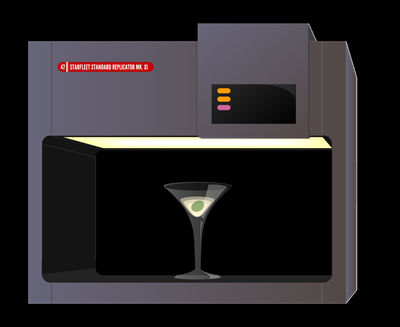 While one of the major milestones of a civilization is the development of faster-than-light propulsion systems, the development of Replicator technology is a close rival milestone as it moves the civilization into a post-scarcity era. Derived from the Transporter, the Replicator
can transform raw materials into virtually any other object stored within its database with safety interlocks preventing users from creating dangerous items. While a starship still carries essential or nonreplicatable spare parts aboard in storage, Replicators free cargo space for the ship to fulfill mission objectives.
While one of the major milestones of a civilization is the development of faster-than-light propulsion systems, the development of Replicator technology is a close rival milestone as it moves the civilization into a post-scarcity era. Derived from the Transporter, the Replicator
can transform raw materials into virtually any other object stored within its database with safety interlocks preventing users from creating dangerous items. While a starship still carries essential or nonreplicatable spare parts aboard in storage, Replicators free cargo space for the ship to fulfill mission objectives.Replicators require energy to reproduce an object, with the larger items taking more time to create, and must have an object stored within its databases before it can be reproduced. To create a Replicator pattern, a thorough scan of the object must be completed and entered into the system. As the Replicator does not operate on the quantum level there are limitations on the production of several items (including living beings and some medications). This recreation is also impacted by the raw materials used to produce the item, which is why some people believe they can taste the difference in foods that are replicated versus the real thing.
Food Replicator
Food Replicators are designed to produce a variety of food and drink and incorporate a menu of over 5,000 different items. Food Replicators are among the most numerous pieces of equipment aboard the Enterprise and are located in shipboard cabins, recreation areas, and even in the command centers and engineering areas.
Industrial Replicator
Distinct from the Food Replicators, Industrial Replicators are commercial units designed to produce primarily spare parts and other inanimate objects. Aboard the Enterprise most Industrial Replicators are larger than the Food Replicators because of the nature of the products that they produce. The largest Industrial Replicators can be 5 meters in size, but these are not as large as some planetary based units.
Tractor Beam
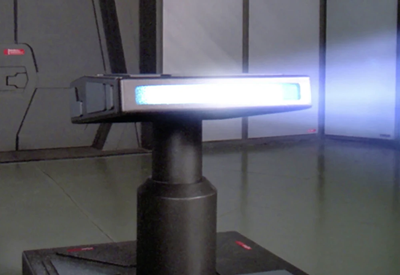 Depending upon the mission profile of a starship it is possible that large objects (like asteroids or other vessels) may have to be cleared, stopped, towed, or subjected to any number of other scenarios by the Enterprise. This manipulation is accomplished by Tractor Beams, specialized energy emitters that bombard a target object with superimposed subspace/graviton force beams placing spatial stress on the target. By manipulating these stress patterns, the ship can either push the object away, pull it closer, or hold it in position.
Depending upon the mission profile of a starship it is possible that large objects (like asteroids or other vessels) may have to be cleared, stopped, towed, or subjected to any number of other scenarios by the Enterprise. This manipulation is accomplished by Tractor Beams, specialized energy emitters that bombard a target object with superimposed subspace/graviton force beams placing spatial stress on the target. By manipulating these stress patterns, the ship can either push the object away, pull it closer, or hold it in position. The Tractor Beam’s effectiveness depends on the target's mass and the speed at which it needs to be moved. Currently, Enterprise's Primary Tractor Beams are mounted on the aft ventral of the ship to assist with towing and the forward ventral to allow items ahead of the ship to be moved out of its path. To help resist the stress and structural imbalance created by their usage, the Tractor Beams have been directly mounted on the primary structural framework of the ship. Secondary Tractor Beams have been placed in each Shuttlebays to help maneuver incoming craft during landings to ensure their safety.
While primarily a utility system aboard the Enterprise, Tractor Beams have multiple military applications. Perhaps their greatest advantage in combat is that Tractor Beams normally prevent most opponents from using their weapons due to the interference generated during their use. Should the enemy be able to fire their weapons the Tractor Beam could potentially deflect the weapon. Further, the interference can also block Transporter signals to prevent people from beaming on and off of the captive vessel, or even to redirect them to a new location. Windows in Tractor Beam interference can sometimes be established to allow transport, but at risk to the person being transported.
While in use a Tractor Beam is susceptible to multiple strategies to disable the device or diminish its effectiveness. The captive vessel may engage its Impulse Engines to try to break free from the Tractor Beam, but it cannot use its Warp Engines as their activation would cause the captive to tear itself to pieces. An opponent may utilize their shields to deactivate a Tractor Beam by remodulating their frequencies, emitting a feedback pulse, or trying to use an antimatter spread to overwhelm the systems. The captive can also attempt to naturally oppose a Tractor Beam using phenomena that interfere with the Tractor Beam emitters, including gravitational effects, magnetic fields, and even a planetary atmosphere.
Transporter
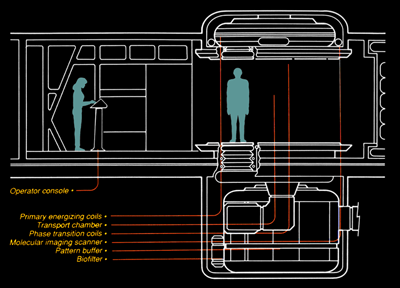 The Transporter, designed by Emory Erickson, has been designed to allow personnel to travel from the ship to other locations without the need of using a shuttle or other small craft. Starfleet Transporters operate by dematerializing their targeted object and transforming it from matter into energy. This energy is then transferred to another location by a narrow-focus subspace carrier wave and rematerialized from energy back into matter exactly as they were when they stepped into the Transporter. In total the entire process for Starfleet Transporters takes around five seconds from start to finish.
The Transporter, designed by Emory Erickson, has been designed to allow personnel to travel from the ship to other locations without the need of using a shuttle or other small craft. Starfleet Transporters operate by dematerializing their targeted object and transforming it from matter into energy. This energy is then transferred to another location by a narrow-focus subspace carrier wave and rematerialized from energy back into matter exactly as they were when they stepped into the Transporter. In total the entire process for Starfleet Transporters takes around five seconds from start to finish. Three Transporter types are currently used aboard the Enterprise. With an operational range of 100,000 kilometers, the Personnel Transporter is the system most people are familiar with. The Personnel Transporter is used to transport humanoids to and from the starship but can also be used to transport cargo and personal property. Emergency Transporters are also installed aboard the Enterprise. Incapable of beaming people aboard the Enterprise, the Emergency Transporter is used to evacuate personnel from the ship and only has a 15,000 kilometer range. Cargo Transporters, which are used to ferry cargo, are located in several Cargo Bays and have a range of 100,000 kilometers like the Personnel Transporters. Despite having a similar range, the Cargo Transporter is not rated for quantum-level operations, which means that they do not work at the molecular level and cannot be used to transport living beings safely. In a crisis a Cargo Transporter can be converted to transport humanoids but are more limited than their counterparts.
Each Transporter type has similar component parts. The Energizing and Transition Coils are used to convert the subject from matter into energy. The Energizing Coils are responsible for generating the Annual Confinement Beam, which creates the spatial matrix where the dematerialization takes place. A secondary field holds the subject within the Annual Confinement Beam to prevent disruption of either field as any disruption would cause a massive energy discharge that would kill the subject. The Emitter and Receiver Arrays located on the outer hull of the ship are used to transmit and receive to their destination.
The transported subject's energy pattern is held by the pattern buffer, a magnetic holding tank, during transport, allowing the Doppler Compensators to adjust for relative motion during transit. For safety reasons each Transporter is outfitted with multiple pattern buffers that can safely store a pattern for a short period of time; nonetheless, if the pattern buffers malfunction or a pattern is kept in the buffer for too long, the subject may begin to suffer from medical effects. Designed during the Federation/Klingon Wars of the 23rd Century, a Transporter Specialist can preserve a pattern by transferring it from one pattern buffer to another so long as the buffers maintain power, but the pattern will be lost if the buffer loses power, is reset, or installs an upgrade.
The Molecular Imaging Scanners map the target on a subatomic level while the targeting scanners locate the transport destination or the person beaming to the ship. As this occurs, the Biofilter scan every pattern for bacterial and viral agents, contraband, or weapons that could pose a danger to the Enterprise's crew. Should a risk be uncovered the Transporter software filters the risks from the matter stream. In some scenarios the Transporter Specialist can override the screening of dangerous items, but command authorization is required.
Transporter Specialists use the control station to monitor and control the Transporter system. Each Specialists receives extensive training in the operation of Transporter systems as the equipment is highly susceptible to interference and malfunction, which poses a significant risk to crew using the Transporter. Further, both Cloaking Devices and Deflector Shields prevent the safe usage of the Transporter while they are engaged. Fortunately, Transporter accidents are rare occurrences as the software managing the Transporter incorporates multiple redundancies and safety protocols to ensure that each transport is routine. When problems do occur personnel must work fast to prevent an improper materialization or losing the Transporter pattern. During any transport a Transporter ID Trace is sent within the subspace carrier wave that can be used to find out what happened and correct the situation.
Before any object can be transported, a lock on the target must be established using the targeting sensors. As the Enterprise's sensors are used to establish the lock, the Transporters are limited by the same interference as the Enterprise's sensors. The Enterprise's Transporters can try to cut through the interference by increasing the power to the Transporter, which tightens the Annual Confinement Beam and increases the sensitivity of the Transporter components. Pattern Enhancers and Isolinear Tags can also be used to enhance and stabilize the signal lock to allow transport. Shields, however, provide the most interference to a Transporter and are not easily overcome. Multiple strategies exist to try to bypass a Shield with a Transporter beam which include trying to match shield modulation with the target, emitting either radions or tachyons toward the opponent's shields, or trying to penetrate a Shield window.
Advanced Transporter Procedures | |
| Used only in emergency situations, a blind beam-out involves transporting all life-forms in a designated area as a group, rather than isolating their individual patterns. | |
| While use of the transporter is monitored by both the ship’s sensors and computers, users can hide use by rerouting the transport grid. This process can also be used to alter a Transporter carrier wave to appear as the carrier wave of another species. | |
| Multiple safety protocols are preprogrammed into the Transporter software to prevent the rematerialization of harmful items. A user can disable these protocols with a command authorization. | |
| Transporter range can be extended by rerouting extra power to the system or by running the pattern through the Main Deflector Dish, extend a transporter’s “reach” to transport someone onto the ship. | |
| In Near Warp Transport, a starship drops out of Warp just long enough to transport the target and then returns to Warp speed. | |
| As Replicators are derived from the Transporter, a user with the appropriate skill can turn a replicator into a transporter by re-aligning the energy-conversion matrix, allowing small objects to be transported. | |
| Site to Site transport allows transport from one location to another without rematerializing within the Transporter Chamber. | |
| If the ship is at Warp by the target is not, the Annular Confinement Beam must be perfectly synchronized with the Warp Core's frequency to safely transport a target. | |
| Postulated by Starfleet Captain Montgomery Scott in the 23rd Century, Transwarp Beaming is an advanced Transporter protocol that allows a target to be safely transported long distances by transporting a target through subspace. | |
| If both the transmitter and receiver vessel are at Warp, both craft must match speeds to allow transport of the target. | |
Waste Recycling
As a spacecraft the Starship Enterprise has limited room aboard for the various equipment, personnel, and resources needed to keep the vessel operational for long periods of time. One complex challenge is each crewmember produces approximately 52 liters of wastewater and sewage per day, requiring the Enterprise to use technology to replicate natural ecologic processes. The Waste Management System aboard the Enterprise completes this vital service and, despite it being the least desired posting for an engineer, is vital to the Enterprise's operations.Wastewater is treated via mechanical filtration processes that remove solids waste and other particulates, moving these to the organic waste processing system. Contaminants are removed from the water and it is subjected to a complex sterilization process and additional filtration before being returned to the water storage tanks aboard the vessel. A similar process is employed for waste sludge; however, the sterilized materials are reprocessed into an organic particulate that is used in the Replicator system. Garbage and other solid waste is categorized by its type and composition, similar to recycling systems used on many Federation worlds. The waste is then transferred to appropriate processors that sterilize and recycle the materials for use in the replicator systems.
While the Enterprise's Waste Recycling Systems are advanced, materials remain that cannot be directly recycled. These materials must be stored to be recycled through a process known as matter synthesis recycling. A complex process, matter synthesis recycling dematerializes the waste materials and then rematerialize them as the desired object. Incredibly energy intensive, hazardous materials are recycled through the matter synthesis process while many everyday items are recycled by traditional means.
Categories: Operations